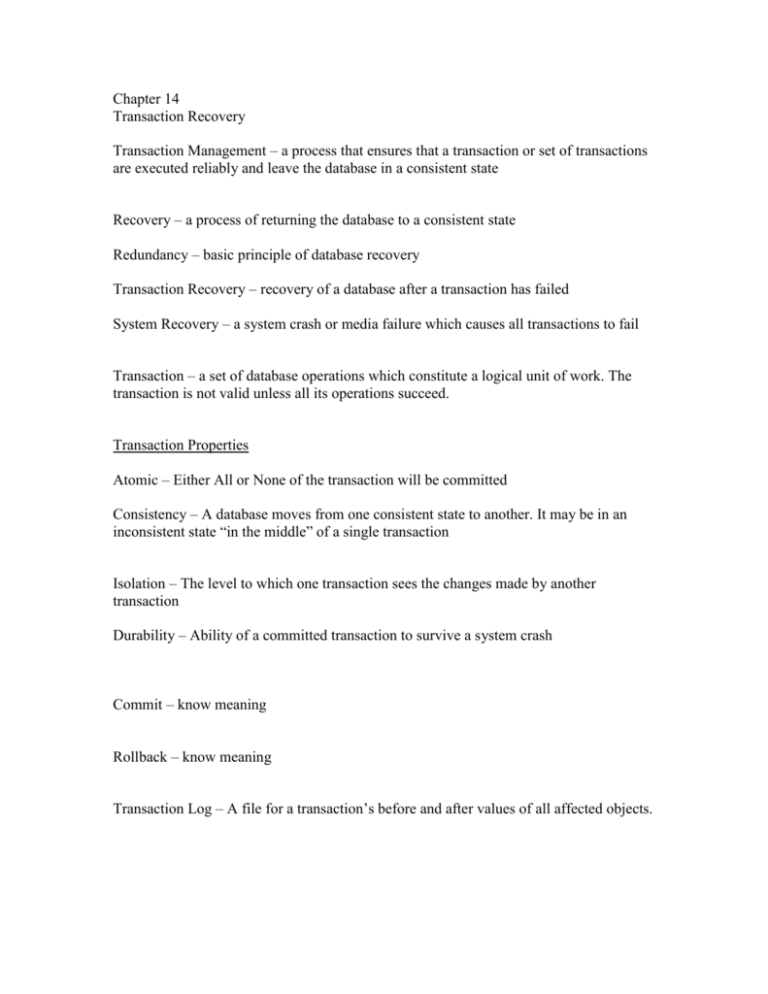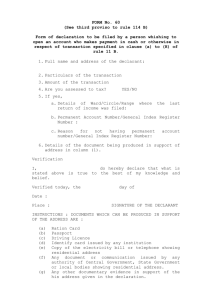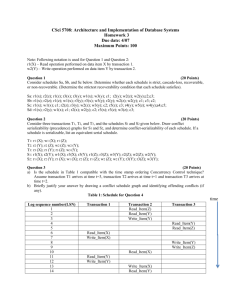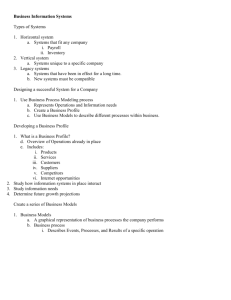Transactions: Recovery and Concurrency Study Notes
advertisement

Chapter 14 Transaction Recovery Transaction Management – a process that ensures that a transaction or set of transactions are executed reliably and leave the database in a consistent state Recovery – a process of returning the database to a consistent state Redundancy – basic principle of database recovery Transaction Recovery – recovery of a database after a transaction has failed System Recovery – a system crash or media failure which causes all transactions to fail Transaction – a set of database operations which constitute a logical unit of work. The transaction is not valid unless all its operations succeed. Transaction Properties Atomic – Either All or None of the transaction will be committed Consistency – A database moves from one consistent state to another. It may be in an inconsistent state “in the middle” of a single transaction Isolation – The level to which one transaction sees the changes made by another transaction Durability – Ability of a committed transaction to survive a system crash Commit – know meaning Rollback – know meaning Transaction Log – A file for a transaction’s before and after values of all affected objects. The Log is made up of an active log and archive log. Transaction Manager (TM) ensures set level updates are atomic despute affecting (possibly) many tuples. A commit point is the instant the decision is made to commit A rollback returns the database to the last commit point At Commit point All changes since last commit are made permanent None of the changes will be undone Tuple locks are released Database positioning with Cursor is lost At Rollback All necessary changes are undone Some tuple locks may be held Some database positioning may be held A Transaction can be a unit of recovery, in case program crashes after commit is called. Before Commit, the log is “force written” On Restart, the log is written and changes are made permenent If program crashes in middle of making permanent changes from Log, Restart will rerun the Log on Restart Transaction Failure – A problem occurs in a single transaction. System is ok, and no other transactions are affected General Failure – Something that affects all transaction occurring at a given time System Failure – Network goes down or a power failure Media Failure – head crash destroys the database or some part of it Checkpoint – know meaning Checkpoint Record – know meaning Media Failure – Can recover database from mose recent tape backup Two-Phase Commit – a process which ensures integrity constraint between 2 independent DBMS TMs. Understand this process. Transaction Concurrency – Allowing multiple transactions to run concurrently or simultaneously Concurrency is not a problem is transactions require different data Classic Concurrent Problems 1. Lost Update – One transaction my nullify the change by another transaction 2. Uncommitted Dependency – One transaction may read a value from another transaction which was never committed 3. Inconsistent Analysis – One transaction sees part “old” part “new” data from another concurrent transaction DB2 Example Cursor Stability – know meaning Repeatable Read – know meaning Transaction deadlock –know meaning, and how it can be broken Locking – a mechanism where a transaction can guarantee that its data space will not be modified by another transaction Lock Types Exclusive Lock – a write lock to indicate the transaction will modify its data space, X Lock Shared Lock – a read lock indicates the transaction will be reading it s data space, S Lock Serializability – a measure of correctness for a set of transactions An execution of a set of transactions is correct if it produces a result equivalent to any serial execution, one at a time. serial schedule – know meaning non-serial schedule – know meaning Serializable schedule – a “correct” non-serial schedule Two-Phase Locking Protocol – guarantees that a non serial schedule is serializable 1. A transaction must acquire a lock before operating on any BD object 2. After 1st lock release, transactions must not acquire any more locks Isolation Level – a measure of the level of concurrency There is an inverse variation of isolation to concurrency, i.e. as isolation increases, concurrency decreases.








